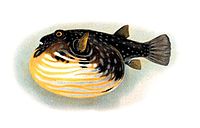
Photo from wikipedia
Highly dynamic environments such as estuaries are home to organisms accustomed to wide fluctuations in environmental conditions. However, estuarine temperature and salinity conditions are expected to shift with climate change,… Click to show full abstract
Highly dynamic environments such as estuaries are home to organisms accustomed to wide fluctuations in environmental conditions. However, estuarine temperature and salinity conditions are expected to shift with climate change, potentially altering plant and animal physiology and consequently their ecological interactions. Phyllaplysia taylori, a sea hare that lives exclusively in nearshore eelgrass beds in the Eastern Pacific Ocean, is a positive ecological interactor with eelgrass by increasing eelgrass productivity through grazing removal of photosynthesis-blocking epiphytes. The central aim of our study is to understand how increasing temperature and salinity are likely to alter that ecological interaction. First, we determined salinity thresholds for survival of P. taylori at 20 °C (typical summer temperature) for 2 weeks, and found that significant mortality occurs at salinity below 25 ppt. Then, we determined respiration rate, grazing rate, and defecation rate of P. taylori following a crossed 2-week acclimation at typical summer low- and high temperatures (18 and 22 °C) and salinities (27 and 33 ppt). P. taylori respiration and grazing rates were elevated under low salinity and high temperature. To determine how P. taylori responds to very warm and extreme summer temperatures, we measured respiration rates at higher temperatures (26 °C—very warm summer and 30 °C—heat shock) and feeding rates following exposure to the 30 °C heat shock. Irrespective of acclimation salinity, P. taylori acclimated to 18 °C were more sensitive to heat shock, as they had a larger increase in respiration rate at 30 °C, and had reduced feeding rates following the 30 °C exposure, whereas there was no reduction in feeding rate in 22 °C acclimated specimens. This study provides the first data on the salinity and temperature sensitivity and metabolic physiology of P. taylori with relevance to their trophic position in the context of eelgrass ecosystems.
Journal Title: Marine Biology
Year Published: 2019
Link to full text (if available)
Share on Social Media: Sign Up to like & get
recommendations!